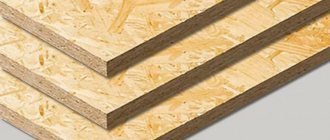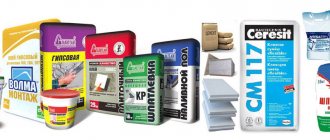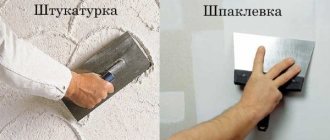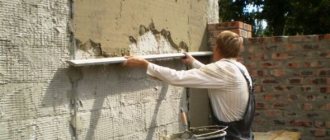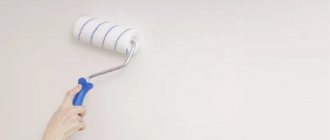Important steps in carrying out repair work are the elimination of large and small defects in the walls, as well as their alignment. The smooth surface lasts much longer and makes it easier to strengthen decorative materials. For this purpose, the coatings are treated with putty, plaster and primer. Depending on the complexity of the process, the mixtures can be used independently or applied in layers.
Features of putty and plaster
Plaster and putty mixtures differ in composition, purpose, and rules of application.
In combination, the use of these materials allows you to level the base, eliminate cracks and chips. The plaster layer precedes the putty layer. The compositions are used to perform high-quality repairs of surfaces for applying decorative plaster with marble imitation, silk-screen printing, performing artificial aging techniques, etc.
Careful leveling and step-by-step surface treatment are necessary before painting the bases with paints and varnishes (water-dispersed, alkyd, acrylic). Painting after treatment of the base is carried out promptly. After preparation, paint consumption per 1 m2 is reduced.
According to its technical characteristics, the putty is durable, resistant to moisture, and quick-drying. The material can be used to seal gaps and small cracks in the base. When choosing a mixture, it is important to consider its purpose (for interior or facade decoration).
What determines the consumption per 1 m2 of wall?
The following parameters affect the putty consumption:
- The condition of the wall panels - the greater the number of protrusions, cracks, rough areas, uneven blocks, the greater the consumption of the putty mixture will be (since the thickness of the composition increases).
- The type of subsequent finishing is painting, whitewashing, wallpapering. Tinting surfaces with paint requires a large consumption of putty per 1 square meter. m.
- Experience of a specialist - beginners in finishing work consume more putty mixture, unlike workers with experience.
- Place of work - when finishing facades and panels in rooms with high humidity, facade putty based on cement powder is used, the consumption of which is higher than gypsum. When performing interior finishing work, dry gypsum mixtures are used, which must be diluted with water, and ready-made putties, which are characterized by low composition consumption.
- Puttying stage - to eliminate unevenness and cracks in the base, a starting solution is used, which has a high consumption. The universal putty mixture has a lower value. Finishing putty is used to level the prepared base for painting or wallpapering, so it is consumed in a small amount.
- Substrate type - wall panels will require more putty than ceilings.
- Composition of the material - more products based on cement powder are required than alkyd putties. Gypsum putty has increased consumption. Less need to order adhesive putty.
When calculating the volume of material, it is necessary to take into account that part of the solution will remain on the tools and in containers for diluting the mixture.
Calculations
Anyone can determine approximate calculations. To begin with, it is important to note that all putty mixtures are released onto the market as starting or finishing mixtures. It is necessary to treat the walls with starting putty at the initial stage of repair work.
Starting
It levels the surface, fills uneven areas, holes or potholes. It is recommended to apply the finishing coat on top of the starting ball. This will create a special, smooth ball suitable for further processing. The walls can then be painted or wallpapered.
Since the starting and finishing materials have different purposes, their consumption will accordingly be different. What is the basis of these meanings?
The amount of material is determined taking into account:
- goals. If you need to get the surface as smooth as possible horizontally or vertically, you will need many times more material than, for example, to prepare the surface for gluing building finishing material for cladding walls and ceilings;
- what is the condition of the treated surface? There may be holes, potholes, or other damage on the walls. Therefore, processing will require a lot of gypsum mixture.
It is recommended to buy putty only from trusted companies, which will have a positive effect on consumption.
Consumption depends on the quality of the material and the area of the wall being treated.
Plaster, as described above, should be applied in several balls. And that is why the described indicators are a relative concept, some use less, some use more, it all depends on the thickness of the layer.
Making an approximate calculation of the amount of putty will allow you to:
- save wasted hours searching for a place to sell excess materials;
- save money that was spent on purchasing excess materials.
Consumption of starting putty
Such mixtures are applied to plastered surfaces and precede the finishing stage. Often the compositions differ in large fractions, because made from gypsum powder and lime. The consumption of the starting putty mixture is high, so manufacturers produce the material in 25-42 kg bags. To dilute 1 kg you will need up to 400 ml of water, the consistency of the material is pasty.
When applying the mixture to a wall panel with a layer of 1 millimeter, the consumption of starting putty will be up to 1-1.4 kg per 1 m2. Typically, 1 package weighing 30 kg is enough to carry out initial puttying of an area of 20-20 m² with small defects. However, if the panels are damaged, the thickness of the putty will be at least 0.5 cm, so a bag will be enough for 4-7 m² of area.
It is recommended to determine the required thickness of 1 layer before puttying work. The standard value is no higher than 0.5-1 cm. If the layer thickness is exceeded, the finishing mixture may shed.
You can calculate how much material is needed taking into account the technical characteristics of different products:
- Knauf HP Start putty can be applied in a layer of 10-30 mm; with a coating of 10 mm, about 7.5 kg will be required for an area of 1 m²;
- Ceresit CT 29 starting mixture is applied with a thickness of 2-20 mm; with a layer of 1 mm, up to 20 kg of product will be required;
- Polimin SHG-11 mixture is used to make a 3-10 mm coating, the consumption with a 1 mm layer will be more than 1 kg;
- SATYN PW-01 - permissible coating up to 8 mm; with a layer of 1 mm, product consumption will be 1.3 kg.
Cost rates for different types of putties
The standard depends on the brand and type of material. The following rules apply:
- Sheetrock is suitable for indoor use. It is used to seal cracks and seams on concrete, brick or other walls, and is used for final finishing. At 1-2 mm the rate of expenditure per sq. m is 0.5-1 kg. For a millimeter layer you will need 0.5 kg.
- Vetonit contains sand, polymer components, cement, limestone, mineral additives, is environmentally friendly and moisture resistant. Work is carried out at +10 degrees. The consumption of Vetonit putty per 1 m2 of plaster is 1.2 kg for a millimeter layer. It dries completely seven days after the work.
- Knauf contains lime, gypsum, glue, is elastic, environmentally friendly, and has high adhesion. Can be used for starting finishing, provided that the size of the unevenness does not exceed 3 mm. The standard is 1.5 kg per square meter.
- For external work, the norm is 1.8-1.16 kg per square meter. meter.
- When applying an oil-adhesive composition, 3 kg per unit area is required.
- For the finishing layer, 0.45 kg is enough.
- Adhesive putty will be consumed at the rate of 0.47 per 1m2.
How to correctly calculate consumption per square meter
The basis for calculating the required volume is the information on the packaging. Here they indicate the consumption per square meter. m with a thickness of 1 mm, as well as the minimum and maximum possible thickness of the coating.
A decision is made as to which processing will be performed: start and finish, station wagon and finish, or station wagon only. The quality of the wall and what layer will be required are assessed.
For example, when using “Polimin SHG-11” the minimum layer is 3 mm, the putty consumption per 1 m2 of plaster is 1.05 kg. The master assessed the unevenness of the wall and decided that 4 mm was needed. The standard will be 4.2 kg (4.2 = 1.05 x 4) per square meter. m.
Consumption of universal putty
The universal putty mixture is applied to the pre-treated surface. Therefore, the use of finishing putty is not necessary. The putty consumption per 1 m2 is 1200-1500 g. Products are sold in packages, the bag weighs 20-25 kg. To finish about 15-20 m² of wall panel, 20 kg of mixture is required.
You need to know what the putty consumption is depending on the manufacturer:
- Stabil PSZ-11
— when applying the material in a layer of 0.1 cm, up to 1.2 kg per 1 m² will be required. However, the consumption of the product increases due to the layer-by-layer coating.
- Sniezka Acryl-Putz
— when applying a layer of 1 mm, up to 1500 g/m² will be required.
- Knauf Multi-Finish
— gypsum products are used at the rate of 1200 g per 1 m². A package weighing 25 kg will be enough for a base area of 20 m².
Consumption of finishing putty per 1 square meter
This mixture is intended for leveling ceilings and walls before painting or applying decorative plaster. The material is produced in the form of a powder or a finished composition, packaged in buckets of 8-25 kg. To prepare a solution from dry material, you need to dilute the powder in water in a ratio of 1:0.5.
The consumption of finishing putty differs depending on the technical features of the compositions of different manufacturers:
- Vetonit LR+
— dry powder contains polymer components, sold in 25 kg packages. For a coating of 1 mm, the consumption will be about 1200 g per area of 1 m². The layer of finishing material should not be more than 1-5 mm.
- Knauf Satengips finishing
— sold in packages of 25 kg. The minimum layer size should be 0.2-5 mm. To cover an area of 1 m² with a layer of 0.1 cm, 1000 g of material is required.
- Volma
— products of this brand are used for finishing plastered concrete surfaces, slag concrete walls, tongue-and-groove slabs, as well as for decorating facades. An area of 1 m² will require up to 1200 g of mixture.
- Knauf uniflot
— the material is used for interior finishing work, adjusting joints between sheets of drywall. The coating does not crack, does not shrink, and is applied in a layer of 1-5 mm. For finishing ceilings, up to 300 g/m² is enough; for partitions, up to 500 g/m² is required. Package size: 5-25 kg.
How much is needed for external and internal walls?
To determine the volume, it is necessary to take into account the characteristics of the area to which the composition is applied. Start-up costs for a façade wall are significantly higher than for an interior wall. Usually the norm is per sq. m is 1 kg or more.
Costs of starting putty
The start is used for leveling. With its help, cracks, chips, and other damage are eliminated. Often the composition uses gypsum or lime.
Usually for every sq. meter you need 1-1.4 kg of composition. This amount is calculated based on a depth of 1 mm. Typically the bag volume is 30 kg. It is enough for 20 sq. m.
The thickness depends on the quality of the material. If there are many defects, then the start can reach up to 5 mm. In this case, spending will increase. Consumption will increase to 4-8 kg per square meter. meter. The thickness must not exceed 1 cm.
To reduce consumption, you need to pre-level the surface. To do this, plastering work is carried out.
For exterior work, the composition is applied to brick, wood, and cinder block. Here the consumption of starting personnel is much greater than for internal work. Usually it exceeds 1 kg per 1m2, sometimes significantly.
Finishing putty costs
It is necessary for the final stage of preliminary wall finishing. Paint will be applied to the finish and wallpaper will be hung. It is not intended to smooth out uneven surfaces, but only to make the wall smoother.
The finish is usually applied to the start. In rare cases, it is used on top of a universal composition. If the wall is smooth and has no defects, then it can be applied immediately. The consumption of finishing putty per 1 m2 is usually less than the starting putty.
It is sold both in the form of a dry powder and in finished form. The last option is the highest quality and most expensive. Sold in packages of 25, 17, 8 kg or smaller. For a coating 1 mm thick, the consumption of finishing putty per 1 m2 of plaster is 1-1.5 liters.
For external walls, the consumption of such a layer is approximately the same as for internal walls. This is due to the fact that it is applied to a flat, prepared surface.
Costs of universal putty
This material is not used for professional finishing. Using a universal mixture, rough leveling is performed. The quality of the resulting surface is inferior to that obtained when using start and finish.
Usually building materials are sold in bags of 20 kg. This is enough for 15-20 sq. meters of wall. On a layer 1 mm thick, the putty consumption per 1 m2 is 1-1.2 kg of mixture. It is used for working on previously prepared surfaces. In this case, no additional finishing is required.
Consumption of ready-mixes for walls
This putty is used to level ceilings and eliminate small defects on walls. The mixtures contain plasticizers and vinyl components that increase the level of surface smoothness. The material dries quickly after application and does not crack. The advantage of the solution is that there is no need for dilution before finishing work.
Consumption of mixtures from different manufacturers:
- Shitrock
- the material is economical. When applying a layer of 1 mm to an area of 1 m², about 50 g of the composition will be required. The putty is easy to apply, does not crack and dries quickly.
- Pufas
- ready-made material from the Ceresit brand, consumed at the rate of 1500-1700 g per 1 m², depending on the thickness of the layer.
- Finished products of the Vetonit brand
- when covering the base with a layer of 1 mm, 1200 g/m² will be required.
- Fugenfüller Knauf
— ready-made gypsum putty can be applied in a continuous layer. An area of 1 m² will require up to 800 g of material. However, when using a gypsum mixture to finish installed tongue-and-groove slabs, the putty consumption will increase to 1500 g/m².
Factors influencing consumption
In addition to the purposes of use and the degree of readiness, the amount of putty used is influenced by the material of the walls and the properties of the surface that will be processed. The main thing to remember is that no matter how accurate the calculations are, you should take the putty with a reserve.
As a rule, the starting layer is made much thicker than the decorative one with a gypsum base. An important factor is the humidity of the room. In a bathroom or basement, a thin finish will not work; a minimum of medium thickness is needed.
Depending on the nature of the defects, several applications of starting and finishing putties may be necessary. There are cases when the sum of all layers exceeded the mark of five. If the wall is almost perfect, then you can get by with leveling and finishing coatings.
Wooden surfaces without proper preparation are not capable of maintaining a thick finishing layer. Therefore, pre-treatment with special primers is required, which subsequently ensures good adhesion. Concrete walls also need priming.
It is worth remembering that putty with excess water can leave unsightly smudges on the wall, significantly reducing the leveling effect. A solution that is too thick can dry out quickly.
To prevent the material from being wasted, it is necessary to calculate the amount of solution for approximately half an hour of work. This can be achieved experimentally.
In addition, it is important to monitor the cleanliness and dryness of the tools used, performing preventive procedures after each kneading.
If you want to save time on trips to hardware stores, then at the stage of calculating the material, it makes sense to look online for photos of putty consumption from different manufacturers. Thanks to this, you can prepare in advance and already know exactly which option and in what quantity you will need to purchase.
How does surface affect consumption per square meter?
To determine the volume of solution consumption, it is necessary to take into account the base material. The volume of the putty mixture differs when applied to plastered surfaces, concrete floors, plasterboard, wood, chipboard sheets, MDF, etc.
Plaster
The consumption of putty per 1 m2 of plaster depends on the quality of the base, the presence of preliminary preparation and an assessment of the planned thickness of the application layer. You can putty only small areas to correct them, or treat the entire surface with a continuous layer.
To create a smooth base, you will need a layer of 1 mm of starting mixture and 0.5 mm of finishing putty. Each composition should be taken at the rate of 1000 g/m² and 600 g/m². When applying denser layers to adjust the base, the volume of the mixture will increase. For a layer of putty 11 mm per 1 m², up to 11 kg of material will be required. When making calculations, the possibility of applying an additional layer (up to 3 mm) is taken into account.
Drywall
The consumption of putty composition per 1 m2 of drywall depends on the number of joints planned for the implementation of the design solution. When treating with a solution, it is necessary to hide the fasteners and screws that are used for mounting plasterboard floors. The work requires a starting and finishing lineup.
The material is selected in accordance with the operating conditions of the space being repaired:
- In rooms with high air humidity, you will need putty with a cement base, the consumption of which ranges from 1100-1200 g per 1 m².
- For dry rooms (bedroom, living room), polymer putties or gypsum mixtures are used. The former are used at a rate of 600-1000 g/m², the latter are consumed economically - 500-1000 g/m².
- The consumption of putty on plasterboard floors will be reduced if the gypsum board sheets are pre-treated with a primer.
Concrete
Before applying the putty mixture to the concrete base, you must first prime it. The material is applied in a layer of no more than 6 mm, the next coating should be about 3 mm. The standard consumption of putty per 1 m2 is about 1-1.5 kg with a layer of 1 mm. With a thickness of 3-6 mm, up to 2-3 kg of material will be required.
Other grounds
When processing wooden surfaces, the putty layer should not be more than 2-3 mm. Accordingly, the volume of material per area of 1 m² is 1100 g. To increase the adhesion of wood, experts recommend priming before treating with putty.
After applying and drying the primer, the volume of materials can be reduced. However, it must be taken into account that coating density and consumption are determined by the composition of products of different brands.
Advice from material consumption consultants
Professional advice that allows you to get high-quality results when leveling walls with putty mixture at its optimal consumption rate:
- the consumption of the building composition directly depends on the mixture used, the surface being treated (depth of defects, curvature) and the thickness of the applied layer (stage of work). This means that pre-leveling the wall with plaster will help reduce putty consumption.
- you need to take into account the type of room when choosing the type of building mixture. For wet rooms (kitchen, bathroom, toilet), cement-based putty is suitable.
- When independently preparing a composition from a dry mixture, you must strictly follow all the instructions indicated on the packaging. If the putty is prepared incorrectly, this will significantly increase its consumption.
- The thicker the composition, the greater the consumption. But this does not mean that to save money you need to dilute the liquid mixture. It all depends on the goals being pursued. For large irregularities, for example, a thick putty is needed
- no need to apply 10 cm layers of plaster, putty, etc. Under the weight of its own weight, there is a high probability that the building material will crack and collapse
Thus, when puttingtying work you need to take into account many nuances:
- work stage
- condition of the walls
- type of building material
- master's qualification, etc.
But on average, without taking into account the unique circumstances of each specific situation, the putty consumption per square meter is 1 kg.
Table describing some putties - consumption rate
The indicators from different manufacturers are as follows:
| Brand | Place of use, description | Consumption rate |
| Shitrock | Interior finishing, the material can be used to correct cracks, chips and as a finishing layer. Characteristics: high ductility, good adhesion | Per 1 m² - about 1 liter with a layer thickness of 1 mm |
| Vetonit | Interior decoration in rooms with dry air. Characteristics: environmentally friendly composition, application at temperatures from +10°C | 1.2 kg/m² with a layer thickness of 1 mm |
| Knauf | Indoor finishing, not applicable for bathrooms and toilets. Characteristics: composition is environmentally friendly, elastic, with a high level of adhesion | For a surface of 1 m² and a layer thickness of 1 mm, 0.8 kg is required |
Tips for preparing the solution
When preparing a putty solution, it is recommended to consider the following nuances:
- The composition is prepared taking into account the instructions from the manufacturer. If the proportions are not correct, the consumption of putty may increase. If there is excess water in the mixture, unaesthetic stains remain on the surface. An overly thick solution will take longer to dry than the standard mixture.
- The volume of the putty solution to be mixed is calculated taking into account the use by the master for 30 minutes.
- To prepare the mixture you will need dry putty and water. You also need a container, a construction mixer or an electric drill with a special attachment operating at low speeds.
- To reduce the amount of solution consumed, it is recommended to use clean tools that are wiped after each mixing.
- When preparing a solution to eliminate large deformations, cracks, and chips, the solution is made thicker. However, the cost of funds will increase.
Recommendations and tips
Puttying is not a complicated process. However, when leveling an uneven wall or, for example, ceilings, it is important not only to apply the putty correctly, but also to correctly make the putty mixture itself. To prepare it you need:
- take a container and add some water to it;
- add a small amount of putty to the container;
- stir the mixture with a spatula until its consistency becomes homogeneous.
To ensure that the mixture is homogeneous, you can also use a drill or screwdriver with a special attachment (mixer) for mixing. During mixing, it is necessary to constantly monitor the level of its consistency and viscosity. If necessary, you can add water to it. The consistency of the finished mixture should be viscous, elastic and adhere well to the spatula. If the mixture flows down the spatula, this means that it is too liquid and you need to add a little dry putty to it.
How to correctly calculate the consumption of façade putty
Putty consumption per 1 m2 for finishing facades is calculated by square meters. The thickness of the facing surface layer is preliminarily determined. In this case, the curvature of the wall panels can be measured using installed beacons. It is important to consider that the level of facade curvature may vary depending on the area chosen for treatment. The standard thickness of putty cladding for facades is 3 cm.
Accordingly, you can perform calculations based on the indicators indicated by the manufacturer on the packaging. Manufacturers describe the volume of material for a layer 10 mm thick. You will need to multiply the figure by 10 to get the required volume of putty.
When carrying out facade work when finishing a 10 m² wall, about 85 kg of specialized putty for external work is required for a 10 mm layer. If you cover the façade more densely with the solution, you will need to perform calculations. It is necessary to take into account the need to purchase material with a margin of 10-15%.

